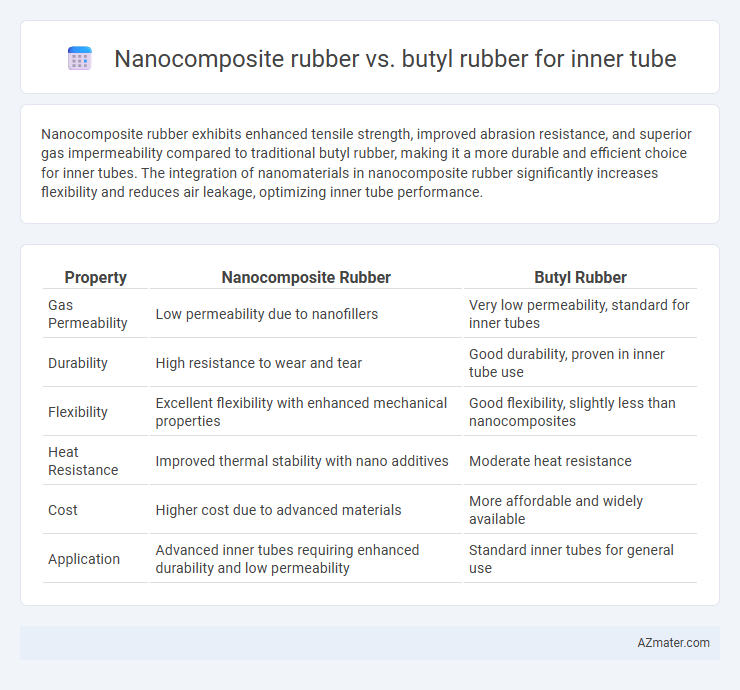Nanocomposite rubber exhibits enhanced tensile strength, improved abrasion resistance, and superior gas impermeability compared to traditional butyl rubber, making it a more durable and efficient choice for inner tubes. The integration of nanomaterials in nanocomposite rubber significantly increases flexibility and reduces air leakage, optimizing inner tube performance.
Table of Comparison
| Property | Nanocomposite Rubber | Butyl Rubber |
|---|---|---|
| Gas Permeability | Low permeability due to nanofillers | Very low permeability, standard for inner tubes |
| Durability | High resistance to wear and tear | Good durability, proven in inner tube use |
| Flexibility | Excellent flexibility with enhanced mechanical properties | Good flexibility, slightly less than nanocomposites |
| Heat Resistance | Improved thermal stability with nano additives | Moderate heat resistance |
| Cost | Higher cost due to advanced materials | More affordable and widely available |
| Application | Advanced inner tubes requiring enhanced durability and low permeability | Standard inner tubes for general use |
Introduction: The Importance of Inner Tube Materials
Inner tube materials critically impact tire performance, durability, and safety, with nanocomposite rubber and butyl rubber being prominent choices. Nanocomposite rubber enhances mechanical strength and air retention due to its nanoscale filler distribution, improving resistance to punctures and gas permeability. Butyl rubber offers excellent impermeability and chemical resistance, making it a traditional material favored for maintaining consistent internal pressure and longevity in inner tubes.
What is Nanocomposite Rubber?
Nanocomposite rubber is a high-performance material enhanced with nanoscale fillers like clay, carbon nanotubes, or silica to improve mechanical strength, gas barrier properties, and durability in inner tubes. Compared to butyl rubber, which is known for its excellent impermeability and elasticity, nanocomposite rubber offers superior resistance to oxygen and moisture permeability, leading to longer-lasting inner tubes. The incorporation of nanofillers enhances tensile strength and thermal stability, making nanocomposite rubber an advanced alternative for inner tube applications requiring improved performance and extended service life.
Understanding Butyl Rubber
Butyl rubber is a synthetic elastomer known for its excellent impermeability to gases, making it a preferred choice for inner tubes in tires where air retention is critical. Compared to nanocomposite rubber, butyl rubber offers superior resistance to heat, chemicals, and ozone, ensuring longer durability and reliability under varied driving conditions. Its unique chemical structure provides enhanced airtightness, reducing the frequency of inflation and improving overall tire performance.
Key Performance Differences
Nanocomposite rubber offers enhanced tensile strength and abrasion resistance compared to butyl rubber, making it more durable for inner tube applications. Its superior gas impermeability reduces air leakage, extending tire life and maintaining consistent pressure. Butyl rubber provides excellent air retention and chemical resistance but falls short in mechanical strength and wear resistance compared to nanocomposite alternatives.
Durability and Longevity Comparison
Nanocomposite rubber exhibits superior durability and longevity compared to butyl rubber for inner tubes due to its enhanced mechanical strength and resistance to abrasion and punctures. The integration of nanomaterials improves the material's elasticity and reduces gas permeability, leading to longer air retention and extended service life. Butyl rubber, while recognized for its excellent air retention, generally shows lower resistance to wear and tear in demanding cycling or automotive conditions.
Air Retention Capabilities
Nanocomposite rubber exhibits superior air retention capabilities compared to Butyl rubber in inner tube applications due to its enhanced barrier properties and reduced gas permeability. The incorporation of nanomaterials such as graphene or clay nanoparticles within the rubber matrix creates a tortuous path for gas molecules, significantly minimizing air leakage. Butyl rubber, while known for good airtightness, lacks the advanced nanostructured reinforcement that enables nanocomposite rubber to achieve longer-lasting inflation and improved performance under varying temperature and pressure conditions.
Resistance to Heat and Chemicals
Nanocomposite rubber demonstrates superior resistance to heat and chemicals compared to butyl rubber, making it ideal for inner tubes exposed to high-temperature environments and harsh chemical conditions. The incorporation of nanomaterials enhances the thermal stability and chemical inertness of nanocomposite rubber, significantly reducing degradation and extending service life. Butyl rubber, though known for its good impermeability and flexibility, tends to degrade faster under extreme heat and aggressive chemicals, limiting its durability in demanding applications.
Flexibility and Handling in Various Conditions
Nanocomposite rubber exhibits superior flexibility compared to butyl rubber, enhancing inner tube performance in varied temperatures and road conditions. Its advanced molecular structure allows better elasticity and improved handling, especially under dynamic stresses and rapid deformation. Butyl rubber provides excellent air retention but tends to be less responsive and stiffer, which can reduce comfort and maneuverability in demanding environments.
Cost Considerations: Nanocomposite vs Butyl
Nanocomposite rubber for inner tubes tends to have higher initial material costs due to advanced filler technologies and manufacturing processes. Butyl rubber remains more cost-effective, benefiting from established production methods and widespread availability. Long-term performance efficiencies of nanocomposite rubber may offset upfront expenses, but Butyl rubber is generally preferred for budget-sensitive applications.
Future Trends in Inner Tube Material Innovation
Nanocomposite rubber enhances inner tube performance by integrating nanoscale reinforcements, offering superior tensile strength, puncture resistance, and thermal stability compared to traditional butyl rubber. Future trends in inner tube material innovation emphasize lightweight formulations, improved gas impermeability, and eco-friendly composites to meet increasing demands for durability and sustainability. Advanced nanomaterials combined with butyl rubber matrices are projected to revolutionize inner tube manufacturing through enhanced elasticity and reduced rolling resistance.

Infographic: Nanocomposite rubber vs Butyl rubber for Inner tube
 azmater.com
azmater.com